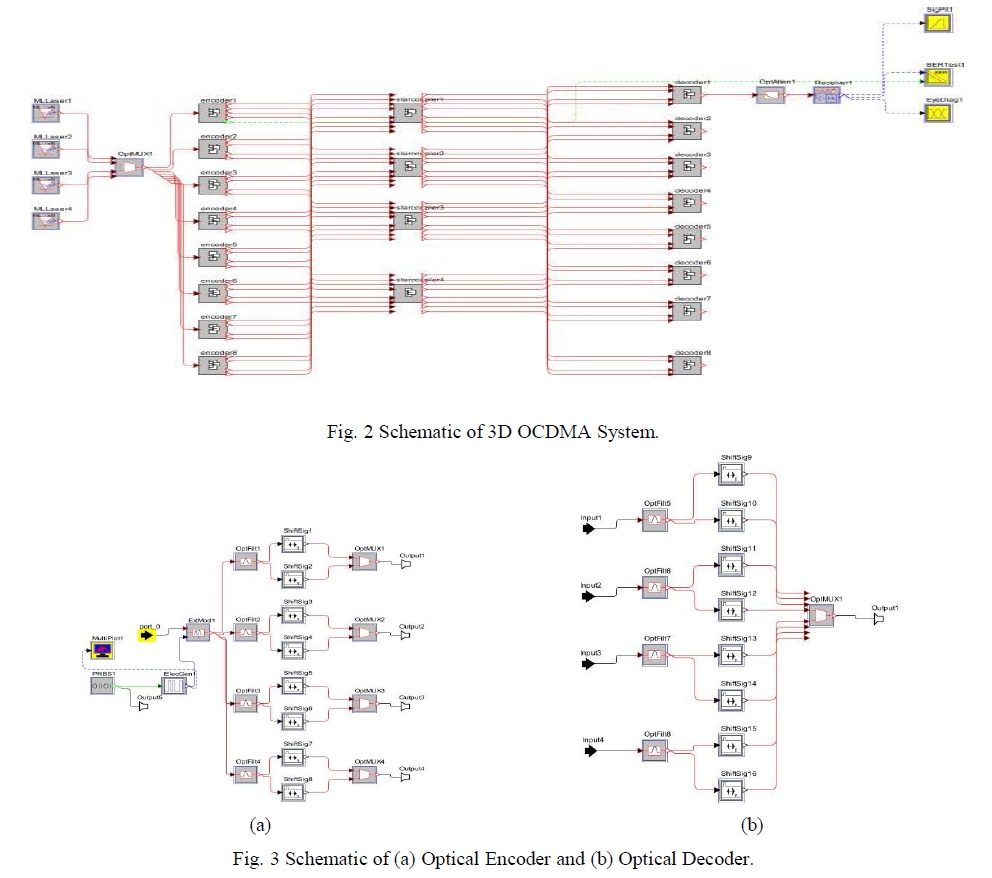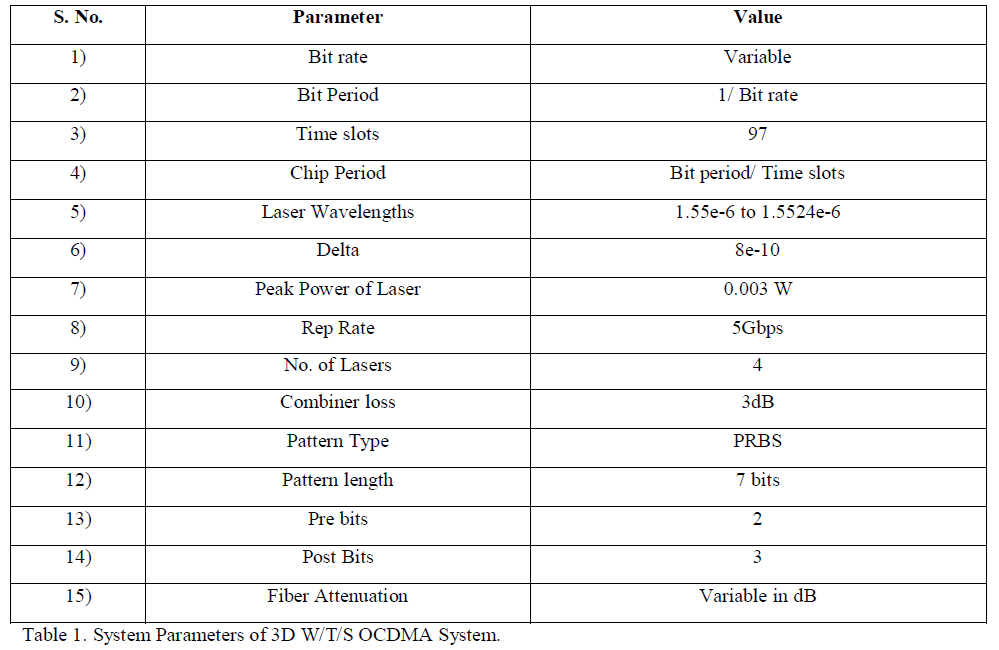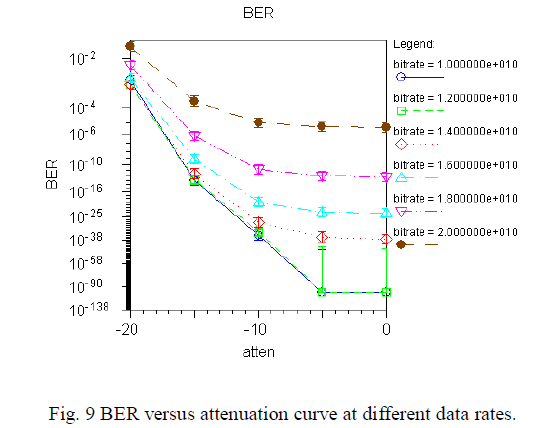Keywords
|
| OCDMA Optical code division multiple access, 3D three dimensional, W/T/S MPR Codes Wavelength/Time/Space Multiple pulses per row codes, LAN Local area network. |
I.INTRODUCTION
|
| OCDMA is an asynchronous multiplexing technique used in bursty LAN environment. OCDMA codes play very important role in analysing the performance of OCDMA systems [1]. In the past many researchers have proposed codesets with different dimensions [2, 3, 5, 7]. We have designed 3D W/T/S MPR codes and using these codes 3D OCDMA system is analysed. |
| There have been various papers published related to OCDMA coding techniques. These codes based upon dimensions used can be divided as one dimensional, two dimensional and three dimensional codes. One dimensional codes are spread in time domain. But as the number of users increases the code length also increases which makes the system bulkier. To overcome the disadvantage of one dimensional codes, two dimensional codes are designed. Shivaleela et.al proposed 2D MPR codes. These codes have good cardinality, spectral efficiency and minimal cross correlation values [6]. Shurong et.al. proposed 2D codes which have good correlation properties [3]. Kim et.al. proposed 3D W/T/S codes based on prime sequence algorithm [7]. Jindal et.al. proposed 3D W/T/S codes based on Modal A and Modal B [4]. The codes proposed in this paper shows performance better than already existing codes. The performance analysis of these system has been done in terms of eye diagrams and BER. |
| This paper is organized as follows: In section II mathematical modelling of 3D W/T/S MPR codes is discussed. In section III design of OCDMA system using 3D W/T/S MPR codes is given with description of its optical encoder and decoder. In section IV performance of this OCDMA system is analysed. The conclusions are drawn in section V. |
II. MATHEMATICAL MODELLING
|
| The codes used in this work are 3D W/T/S MPR codes. W/T/S MPR codes can be characterized as by N(R X LT X S, W, λa=1, λc=1) where, N is the number of codes, R is the number of wavelengths, LT is the number of timeslots, S is no of code channels, W is the weight of the code, WP = W/R is the weight per row, λa is the peak out-of-phase autocorrelation and λc is the peak cross-correlation |
| The earlier proposed codes i.e. W/T MPR codes are further extended using space as third dimension. W/T/S 3D codes can be constructed by extending 2D W/T MPR codes [6]. For a fixed W/T MPR code, we can generate as many codes as we want by changing the spatial channel S. But the number of spatial channel is limited by number of wavelengths i.e. S ≤ R. So only fixed number of 3D codes can be generated but we can increase number of wavelengths used so number of spatial channels can also be increased. |
| In assigning wavelength to each spatial channel, we need to keep the orthogonality by constraining cross-correlation between any two codewords with different temporal distributions of pulses over spatial channels less than or equal to 1. Note that cross-correlation between any two codewords with the same temporal distribution cannot be greater than 1 because of the orthogonality of the 2-D code. To extend 2-D codes to 3-D codes without losing orthogonality, we only need to assign wavelengths to each spatial channel such a way that any two distinct codewords have no more than one spatial channel of the same wavelength. Hence using method we can generate new 3D code. |
III. DESIGN OF 3D OCDMA SYSTEM
|
| Fig. 2 shows the schematic of 3D W/T/S OCDMA system for zero transmission length. In this system, W/T/S code is implemented when transmission length is 0 Km. This system is used to analyze the performance of the system when a 3D MPR code is implemented. This system has 4 wavelengths, 97 timeslots and 4 spatial channels. This system is supporting 8 active users simultaneously. |
 |
| Fig. 3 shows the schematic of optical encoder and decoder used in OCDMA system. Each signal in encoder is provided with time delay. This time delay can be calculated using equation 1. |
| Time delay= Code* Chip period, |
| Where Chip period (Tc) = Bit period (Tb)/Total Number of Time slots (LT). |
| In this system multiple pulses per row are used, so there will be multiple delays provided to each wavelength. Then signal from delay line are multiplexed. |
| Table 1 shows the parameters employed during the simulation of OCDMA System. |
 |
IV. RESULT AND DISCUSSION
|
| The system uses 4 different wavelengths λ1= 1.55e-6, λ2= 1.5508e-6, λ3= 1.5516e-6 and λ4= 1.5524e-6. Now the performance of system is analysed at different data rates and attenuations. The data rates used in this system are 10 Gbps, 12 Gbps, 14 Gbps, 16 Gbps and 18 Gbps. Fig. 4 to Fig. 8 shows eye diagrams obtained at different data rates and attenuations. |
 |
| These are the eye diagrams observed at a bit rate of 10 Gbps. These results are obtained for zero transmission length and various attenuations. We can observe from the eye diagrams as attenuation increases interference increases and signal gets distorted. |
 |
| These are the eye diagrams obtained at a data rate of 12 Gbps. These results are observed for various attenuations values. It can be observed from the eye diagrams as attenuation increases interference increases and signal gets distorted. |
 ` ` |
| Fig. 6 shows the eye diagrams obtained at a data rate of 14 Gbps. The observations are made for various attenuations values. It is observed from the eye diagrams as attenuation increases interference increases and signal gets distorted. |
 |
| Fig. 7 shows the eye diagrams observed at a data rate of 16 Gbps. The results have been observed for various attenuations values. The eye diagrams shows that attenuation increases with increase in interference and signal gets distorted. |
 |
| Fig. 8 shows the eye diagrams obtained at a data rate of 18 Gbps. The observations are made for various attenuations values. It is observed taht this system can work up to a data rate of 18 Gbps and attenuation of -15 dB. |
 |
 |
| Fig. 9 shows the BER v/s attenuation curve at different data rates. In this curve it can be observed that as attenuation goes from 0 to -20dB BER increases which mean noise gets added into the system. The output of this system is unacceptable at data rate of 20 Gbps. This system can support bit rate up to 18 Gbps and an attenuation of -15 dB. |
| In earlier proposed system given by Jindal et.al. [1,4] the data rate supported by those systems was 10 Gbps at maximum attenuation of -5dB. But the systems presented in this paper can support data rate of 18 Gbps at an attenuation of -15dB. Hence using 3D W/T/S MPR codes the performance of system improves. |
V.CONCLUSION
|
| In the present work, an OCDMA system is designed successfully using 3D W/T/S MPR codes. The performance of this system is analysed. This system can support 8 active users and 18 Gbps of data rate. BER of this system is less than 1.0e-9 which is acceptable. Even in the presence of attenuation this system gives satisfactory results which make the 3D W/T/S MPR OCDMA system suitable for LAN networks. Proposed system is compared with already existing 3D OCDMA system given by Jindal et.al. [1,4] and found that these systems work at higher data rate and gives satisfactory performance even at high attenuation. |
References
|
- Shilpa Jindal, N Gupta,” Performance Analysis of Transmission of 5 Users Based on Model B Using GF (5) with Varying Bit Rates for 3DOCDMA System” ICCSEA, SPPR, CSIA, pp. 97–106, 2013.
- Jawad A Salehi ,“Code Division Multiple-Access Techniques in Optical Fiber Networks-Part I: Fundamental Principles” IEEE Transactionson Communications, Volume 37, Number. 8, August 1989. Pg 824 -833.
- Sun Shurong, Hongxi Yin, Ziyu Wang, and AnshiXu,” A New Family of 2D Optical Orthogonal Codes and Analysis of Its Performance inOptical CDMA Access Networks” Journal of Lightwave Technology, Vol. 24, No. 4, April 2006.
- Shilpa Jindal, NeenaGupta,”Simulated Transmission of Four Users with 5 WDM × 4 TDM × 4 CODE at 20 Gbps 3D OCDMA System Basedon Model A Using GF (5)” Photonics and Optoelectronics (P&O) Volume 2 Issue 3, July 2013
- Bih-ChyunYeh, Cheing-Hong Lin, and Jingshown Wu,” Noncoherent Spectral/Time/Spatial Optical CDMA System Using 3-D PerfectDifference Codes” Journal of Lightwave Technology, Vol. 27, No. 6, March 2009.
- E. S. Shivaleela, A. Selvarajan and T. Srinivas,” Two-Dimensional Optical Orthogonal Codes for Fiber-Optic CDMA Networks” Journal ofLightwave Technology, Vol. 23, No. 2, Feb 2005.
- Sangin Kim, Kyungsik Yu, and Namkyoo Park,” A New Family of Space/Wavelength/Time Spread Three-Dimensional Optical Code forOCDMA Networks” Journal of Lightwave Technology, Vol. 18, No. 4, April 2000.
|